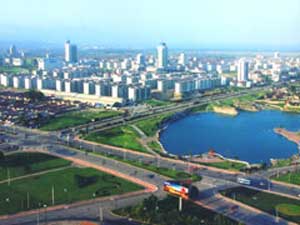China's Solar-Powered City

Photo Credit: rz.gov.cn
Buildings in Rizhao, a coastal city of nearly three million on the Shandong Peninsula in northern China, have a common yet unique appearance: most rooftops and walls are covered with small panels. They are solar heat collectors.
A combination of regulations and public
education spurred the broad adoption of solar heaters. The city
mandates all new buildings to incorporate solar panels, and it
oversees the construction process to ensure proper installation. To
raise awareness, the city held open seminars and ran public
advertising on television.
In total, the city has over a half-million square meters of solar water heating panels, the equivalent of about 0.5 megawatts of electric water heaters.
The fact that Rizhao is a small, ordinary Chinese city with per capita incomes even lower than in most other cities in the region makes the story even more remarkable. The achievement was the result of an unusual convergence of three key factors: a government policy that encourages solar energy use and financially supports research and development, local solar panel industries that seized the opportunity and improved their products, and the strong political will of the city's leadership to adopt it.
As is the case in industrial countries that promote solar power, the Shandong provincial government provided subsidies. Instead of funding the end users, however, the government funded the research and development activities of the solar water heater industry.
Mayor Li Zhaoqian explained: "It is not realistic to subsidize end users as we don't have sufficient financial capacity." Instead, the provincial government invested in the industry to achieve technological breakthroughs, which increased efficiency and lowered the unit cost.
The cost of a solar water heater was brought down to the same level as an electric one: about $190, which is about 4-5 percent of the annual income of an average household in town and about 8-10 percent of a rural household's income. Also, the panels could be simply attached to the exterior of a building. Using a solar water heater for 15 years costs about 15,000 Yuan less than running a conventional electric heater, which equates to saving $120 per year.
A combination of regulations and public education spurred the broad adoption of solar heaters. The city mandates all new buildings to incorporate solar panels, and it oversees the construction process to ensure proper installation. To raise awareness, the city held open seminars and ran public advertising on television. Government buildings and the homes of city leaders were the first to have the panels installed. Some government bodies and businesses provided free installation for employees, although the users pay for repairs and replacement.
After 15 years of effort, it seems the merit of using a solar heater has become common sense in Rizhao, and "you don't need to persuade people anymore to make the choice," according to Wang Shuguang, a government official.
Widespread use of solar energy reduced the use of coal and help improve the environmental quality of Rizhao, which has consistently been listed in the top 10 cities for air quality in China. In 2006, the State Environmental Protection Agency designated Rizhao as the Environmental Protection Model City.
Rizhao's leaders believe that an enhanced environment will in turn help the city's social, economic, and cultural development in the long run, and they see solar energy as a starting point to trigger this positive cycle. Some recent statistics show Rizhao is on track. The city is attracting a rapidly increasing amount of foreign direct investment, and according to city officials, environment is one of the key factors bringing these investors to Rizhao.
The travel industry in the city is also booming. In the last two years, the number of visitors increased by 48 and 30 percent respectively. Since 2002, the city has successfully hosted a series of domestic and international water sports events, including the International Sailing Federation's Grade W 470 World Sailing Championship.
The favorable environmental profile of Rizhao is changing its cultural profile as well, by attracting high-profile universities and professors to the city. Peking University, the most prestigious one in China, is building a residential complex in Rizhao, for example. More than 300 professors have bought their second or retirement homes in the city, working and living in this new complex at least part of the year. Qufu Normal University and Shandong Institute of Athletics have also chosen Rizhao for new campuses.
Xuemei Bai is a Scientist in the Urban Systems Program for the Commonwealth Scientific and Industrial Organization in Australia. This article was adapted from an article that first appeared in the recently released report State of the World 2007: Our Urban Future, and was reprinted with permission from the Worldwatch Institute.
For Further Information
 To subscribe or visit go to:
http://www.renewableenergyaccess.com
To subscribe or visit go to:
http://www.renewableenergyaccess.com